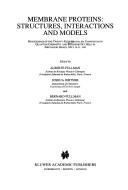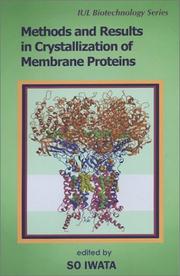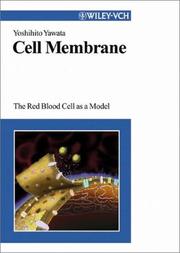| Listing 1 - 10 of 347 | << page >> |
Sort by
|
Book
Abstract | Keywords | Export | Availability | Bookmark
 Loading...
Loading...Choose an application
- Reference Manager
- EndNote
- RefWorks (Direct export to RefWorks)
Osmotically Driven Membrane Processes provides an overview of membrane systems and separation processes, recent trends in membranes and membrane processes, and advancements in osmotically driven membrane systems. It focuses on recent advances in monitoring and controlling wastewater using membrane technologies. It explains and clarifies important research studies as well as discusses advancements in the field of organic-inorganic pollution.
Book
Abstract | Keywords | Export | Availability | Bookmark
 Loading...
Loading...Choose an application
- Reference Manager
- EndNote
- RefWorks (Direct export to RefWorks)
Osmotically Driven Membrane Processes provides an overview of membrane systems and separation processes, recent trends in membranes and membrane processes, and advancements in osmotically driven membrane systems. It focuses on recent advances in monitoring and controlling wastewater using membrane technologies. It explains and clarifies important research studies as well as discusses advancements in the field of organic-inorganic pollution.
Book
Abstract | Keywords | Export | Availability | Bookmark
 Loading...
Loading...Choose an application
- Reference Manager
- EndNote
- RefWorks (Direct export to RefWorks)
Osmotically Driven Membrane Processes provides an overview of membrane systems and separation processes, recent trends in membranes and membrane processes, and advancements in osmotically driven membrane systems. It focuses on recent advances in monitoring and controlling wastewater using membrane technologies. It explains and clarifies important research studies as well as discusses advancements in the field of organic-inorganic pollution.

ISBN: 0792319516 9780792319511 Year: 1992 Publisher: Dordrecht: Kluwer,
Abstract | Keywords | Export | Availability | Bookmark
 Loading...
Loading...Choose an application
- Reference Manager
- EndNote
- RefWorks (Direct export to RefWorks)
Book
ISBN: 0323988962 Year: 2022 Publisher: Cambridge, Massachusetts : Academic Press,
Abstract | Keywords | Export | Availability | Bookmark
 Loading...
Loading...Choose an application
- Reference Manager
- EndNote
- RefWorks (Direct export to RefWorks)

ISBN: 9780963681799 0963681796 Year: 2003 Publisher: La Jolla, Calif.: International Unversity Line,
Abstract | Keywords | Export | Availability | Bookmark
 Loading...
Loading...Choose an application
- Reference Manager
- EndNote
- RefWorks (Direct export to RefWorks)
Dissertation
Abstract | Keywords | Export | Availability | Bookmark
 Loading...
Loading...Choose an application
- Reference Manager
- EndNote
- RefWorks (Direct export to RefWorks)
Membrane Proteins --- Membrane Proteins --- immunology. --- physiology.
Book
Year: 2013 Publisher: Bruxelles: UCL. Faculté de pharmacie et des sciences biomédicales,
Abstract | Keywords | Export | Availability | Bookmark
 Loading...
Loading...Choose an application
- Reference Manager
- EndNote
- RefWorks (Direct export to RefWorks)
La membrane n'est plus perçue comme homogène mais montre une hétérogénéité latérale à deux niveaux : les rafts nanométriques transitoires et les domaines micrométriques stables, détectés dans la membrane plasmique d'érythrocytes et de cellules CHO grâce à l'insertion d'analogues lipidiques fluorescents (BODIPY) à des concentrations traceuses. Cependant, les rôles potentiels des domaines micrométriques en physiologie, par exemple pour la migration cellulaire, restent à éclaircir. J'ai examiné cette question en utilisant comme modèle cellulaire des myoblastes C2Cl2. J'ai d'abord vérifié par imagerie confocale vitale que des analogues fluorescents de sphingolipides ([SLs*] : sphingomyéline [SM*] et deux glycosphingolipides [GSLs*], le galactosylcéramide [GalCer*] et le ganglioside GMl [GMl*]) forment des domaines micrométriques à la face ventrale des myoblastes. Les domaines mis en évidence grâce aux SLs fluorescents reflètent l'organisation des SLs endogènes puisque le marquage du GMl* exogène co ï1cide avec le marquage du GMl endogène reconnu par la sous-unité de liaison de la toxine du choléra fluorescente .Après ces vérifications, j'ai recherché s'il existait une relation entre l'organisation des SLs* et la migration des myoblastes exposés à l'insulin-like growth factor-1 {IGF-1). J'ai observé une polarisation préférentielle de la SM* au front de migration et des GSLs* à l'extrémité postérieure et une libération de microvésicules,dont la composition lipidique est hétérogène. La polarisation de la SM* et la libération de microvésicules dépendent du temps de migration et sont réduites par l'inhibition des calpa ï1es (Calpa h lnhibitor Il),de la phosphoinositide-3-kinase (Pl3K; LY294002) et de Rac (NSC23766), des protéines régulatrices de la migration cellulaire. La polarisation de la SM* est supprimée par la déplétion du contenu membranaire en cholestérol (méthyl--cyclodextrine), ce qui suggère l'importance d'un contenu optimal en cholestérol pour la polarisation de ce SL*.J'ai enfin commencé à étudier les implications éventuelles de la polarisation antéro-postérieure des SLs*. J'ai d'abord testé si cette polarisation pouvait favoriser le recrutement de protéines régulatrices de la migration cellulaire. J'ai montré que le récepteur de l'IGF-1(IGF-lR) est recruté au front de migration alors que pPAKl (p21-activated kinase1) et CD44 (le récepteur de l'hyaluronanne) sont plutôt à la membrane postérieure, mais je n'ai pas pu réaliser des co-marquages avec les SLs*. J'ai ensuite recherché par FRAP (fluorescence recovery after photobleaching) si la polarisation pouvait créer une tension membranaire différentielle et j'ai observé que la diffusion de la SM* est restreinte au front de migration mais pas à l'extrémité postérieure. La restriction est levée par l'inhibition de la migration cellulaire (Calpaïn l' lnhibitor 11, LY294002, NSC23766) et par la déplétion en cholestérol. Ces résultats indiquent une tension membranaire plus importante au front de migration.En conclusion, la SM* et les GSLs* forment des domaines micrométriques à la face ventrale des myoblastes et une polarisation antéro-postérieure pendant la migration cellulaire. La polarisation antérieure de la SM* est reflétée par une restriction à sa diffusion latérale et dépend du cholestérol. Long viewed as homogenous solvent for membrane proteins, the lipid bilayer shows lateral heterogeneity at two different scales : transient nanometric "lipid rafts" vs stable micrometric assemblies, visualized upon insertion of trace levels of fluorescent (BODIPY) lipid analogs in the plasma membrane of erythrocytes and CHO cells. Implications of micrometric lipid domains in physiological processes, such as cell migration, are poorly understood. C2C12 myoblasts are an excellent experimental model to examine this question. 1 first verified that fluorescent analogs of sphingolipids ([SLs] : sphingomyelin [SM*) and two glycosphingolipids [GSLs*], galactosylceramide [GafCer*) and the ganglioside GMl [GMl*]) labelled micrometric domains at the ventral surface of myoblasts. Micrometric domains labelled by exogenous fluorescent Sls reflected a behaviour of corresponding endogenous Sls, as shown by the colocal1zation between GMl* domains and endogenous GMl stained by the fluorescent cholera toxin binding subunit. After these verifications, 1 evaluated whether a relation can be established between SL* membrane organization and migration of myoblasts exposed to insulin-like growth factor-1 {IGF-1). 1 observed that SM* and GSLs* were preferentially found at the leading and trailing edges, respectively, and that migrating cells released microvesicles of heterogeneous lipid composition. SM* polarization at the leading edge and microvesicles formation were time-dependent and strongly reduced upon abolishment of cell migration by inhibitors of calpains (Calpain lnhibitor Il), phosphoinositide-3-kinase (Pl3K; LY294002) and Rac (NSC23766). SM* polarizat1on was also suppressed by cholesterol depletion (methyl-{3-cyclodextrin), indicating importance of membrane cholesterol content and/or organization for SM* polarization at the leading edge.I finally began to study potential implications of SL* antero-posterior polarization. According to our first hypothesis, SL* polarization could favor recruitment of regulatory proteins of cell migration. 1 first showed that the receptor for IGF-1 (IGF- R) was recruited at the leading edge,and pPAKl (p21-activated kinase1) and CD44 (receptor for hyaluronic acid) to the posterior membrane, but 1 did not have time to compare with SM* and GSLs* organization. According to our second hypothesis, SL* antero-posterior polarization could create differential membrane tension. Using FRAP (fluorescence recovery after photobleaching), 1 found that SM* lateral diffusion was restricted at the leading edge. Restriction was relaxed by inhibitors of calpains, Pl3K and Rac and by cholesterol depletion, suggesting higher membrane tension at the leading edge. ln conclusion, SM* and GSLs* spontaneously clustered into micrometric domains at the ventral surface of myoblasts and showed an antero-posterior polarity in migrating cells. SM* polarization at the leading edge was functionally reflected by restriction of its lateral mobility and depended on cholesterol.
Membrane Proteins --- Sphingolipids --- Myoblasts
Book
Year: 1988 Publisher: Chicago (Ill.) : University of Chicago press,
Abstract | Keywords | Export | Availability | Bookmark
 Loading...
Loading...Choose an application
- Reference Manager
- EndNote
- RefWorks (Direct export to RefWorks)

ISBN: 3527304630 9783527304639 Year: 2003 Publisher: Weinheim: Wiley,
Abstract | Keywords | Export | Availability | Bookmark
 Loading...
Loading...Choose an application
- Reference Manager
- EndNote
- RefWorks (Direct export to RefWorks)
| Listing 1 - 10 of 347 | << page >> |
Sort by
|

 Search
Search Feedback
Feedback About UniCat
About UniCat  Help
Help News
News